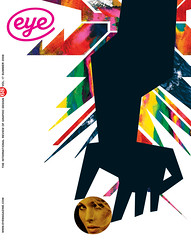Summer 2008
Redouane Oumahi
Who cares about graphic design history?

Redouane Oumahi is from France and graduated from the London College of Communication in 2003.
Q1. What do you think is meant by ‘the canon of graphic design history’? For example: The Bauhaus? Beck’s Underground diagram, etc.? Do you ever think about it, or buy design history publications?
A1. The examples you mentioned can be compared to ‘city landmarks’ such as Big Ben or the Eiffel Tower. They are bold statements, and we may or may not be fascinated by them.
I don’t buy design history publications, or any publication for that matter. History is a giant library open 24 hours a day, every day. I try to go there once a week.
Q2. Does this kind of design history have relevance to what you do in your design practice?
A2. Yes and no. Some more than others. And up to a certain degree only.
Q3. Where did you learn about design history (if at all)?
A3. I learned about design history from Richard Hollis’s Graphic Design, A Concise History before starting my degree course at London College of Communication in 2000.
Q4. Does history have any relevance to the new technology and techniques you’ve had to master in your work?
A4. Yes. old processes and technique can still be used today, or even be mixed with modern techniques and media. I never deny the past, I always embrace it.
Q5. If you were in charge of a design education programme, what aspects of design history (if any) would you teach to your students?
A5. Design history and its application in the business world. From idea to commercial success (or failure), the whole process. Also, the fine line between art and design: at what point design becomes art (and vice versa)?
Top: Illustration for inclusion in a ‘meltin’ pack’ distributed by French promotion company Konkrite. Design: Redouane Oumahi, Ohlala Studio, 2007.
First published in Eye no. 68 vol. 17 2008
Eye is the world’s most beautiful and collectable graphic design journal, published quarterly for professional designers, students and anyone interested in critical, informed writing about graphic design and visual culture. It is available from all good design bookshops and online at the Eye shop, where you can buy subscriptions and single issues.

